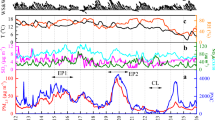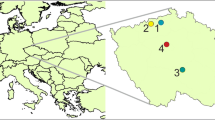Abstract
Particle number concentration was measured in 2011 in the Yellow River Delta (YRD) of eastern China. The objectives were to study the number size distribution characteristics of ambient aerosols and the meteorological effects on the particle physical characterisation, in addition to investigating the new particle formation (NPF) events in the Yellow River Delta. The particle formation rates and growth rates of the newborn particles were evaluated to identify the new particle formation events. The annual median total number concentration (5–10,000 nm) was 10,349 cm−3, with a maximum concentration in autumn and lowest in winter. A higher number concentration was observed for Aitken mode particles than for accumulation and nucleation mode particles. Higher temperature and lower humidity could favour the homogeneous nucleation. With increasing wind speed, the Aitken and accumulation mode particle numbers decreased obviously, and the particle sizes were reduced. Higher particle number concentrations were associated with southeast local air masses which passed from polluted area, and smaller diameter peaks were associated with northern air masses. In total, 26 new particle formation events were recorded during the 120 days of measurements, and this frequency was slightly lower than that observed in other cities in China. The mean growth and formation rates were calculated as 5.3 nm h−1 and 6.6 cm−3 s−1, respectively. High SO2 and O3 concentrations might have contributed to the increase in nucleation mode particles in the NPF events.







Similar content being viewed by others
References
Agus EL, Young DT, Lingard JJ, Smalley RJ, Tate JE, Goodman PS, Tomlin AS (2007) Factors influencing particle number concentrations, size distributions and modal parameters at a roof-level and roadside site in Leicester, UK. Sci Total Environ 386:65–82
Asmi A, Wiedensohler A et al (2011) Number size distributions and seasonality of submicron particles in Europe 2008–2009. Atmos Chem Phys 11:5505–5538
Ayala A, Brauer M, Mauderly JL, Samet JM (2012) Air pollutants and sources associated with health effects. Air Qual Atmos Health 5:151–167
Birmili W, Wiedensohler A (2000) New particle formation in the continental boundary layer: meteorological and gas phase parameter influence. Geophys Res Lett 27:3325–3328
Birmili W, Berresheim H, Plass-Dülmer C, Elste T, Gilge S, Wiedensohler A, Uhrner U (2003) The Hohenpeissenberg aerosol formation experiment (HAFEX): a long-term study including size-resolved aerosol, H2SO4, OH, and monoterpenes measurements. Atmos Chem Phys 3:361–376
Bismarck-Osten C, Birmili W, Ketzel M, Massling A, Petäjä T, Weber S (2013) Characterization of parameters influencing the spatio-temporal variability of urban particle number size distributions in four European cities. Atmos Environ 77:415–429
Dal Maso M, Kulmala M, Riipinen I, Wagner R, Hussein T, Aalto PP, Lehtinen KE (2005) Formation and growth of fresh atmospheric aerosols: eight years of aerosol size distribution data from SMEAR II, Hyytiala, Finland. Boreal Environ Res 10:323–336
Draxler R, Rolph GD HYSPLIT (hybrid single-particle Lagrangian integrated trajectory) model access via NOAA ARL READY website. Silver Spring, MD: NOAA Air Resources Laboratory; 2003
Draxler R, Stunder B, Rolph G, Stein A, Taylor A (2009) Hysplit4 user—guide. National Oceanic and Atmospheric Administration
Fann N, Risley D (2013) The public health context for PM2.5 and ozone air quality trends. Air Qual Atmos Health 6:1–11
Gao J, Wang T, Zhou X, Wu W, Wang W (2009) Measurement of aerosol number size distributions in the Yangtze River delta in China: formation and growth of particles under polluted conditions. Atmos Environ 43:829–836
Gao J, Chai F, Wang T, Wang W (2011) Particle number size distribution and new particle formation (NPF) in Lanzhou, Western China. Particuology 9:611–618
Gao J, Chai F, Wang T, Wang S, Wang W (2012) Particle number size distribution and new particle formation: new characteristics during the special pollution control period in Beijing. J Environ Sci 24:14–21
Gómez-Moreno FJ, Pujadas M, Plaza J, Rodríguez-Maroto JJ, Martínez-Lozano P, Artíñano B (2011) Influence of seasonal factors on the atmospheric particle number concentration and size distribution in Madrid. Atmos Environ 45:3169–3180
Harris SJ, Maricq MM (2001) Signature size distributions for diesel and gasoline engine exhaust particulate matter. J Aerosol Sci 32:749–764
He M, Sun Y, Li X, Yang Z (2006) Distribution patterns of nitrobenzene’s and polychlorinated biphenyls in water, suspended particulate matter and sediment from mid-and down-stream of the Yellow River (China). Chemosphere 65:365–374
Kerminen V-M, Pirjola L, Kulmala M (2001) How significantly does coagulational scavenging limit atmospheric particle production? J Geophys Res. 106:24119-24125
Kim YJ, Kim KW, Kim SD, Lee BK, Han JS (2006) Fine particulate matter characteristics and its impact on visibility impairment at two urban sites in Korea: Seoul and Incheon. Atmos Environ 40:593–605
Kopanakis I, Chatoutsidou SE, Torseth K, Glytsos T, Lazaridis M (2013) Particle number size distribution in the eastern Mediterranean: formation and growth rates of ultrafine airborne atmospheric particles. Atmos Environ 77:790–802
Kulmala M, Toivonen A, Mäkelä JM, Laaksonen A (1998) Analysis of the growth of nucleation mode particles observed in Boreal forest. Tellus B 50:449–462
Kulmala M, Vehkamäki H, Petäjä T, Dal Maso M, Lauri A, Kerminen VM, Birmili W, McMurry PH (2004) Formation and growth rates of ultrafine atmospheric particles: a review of observations. J Aerosol Sci 35:143–176
Kulmala M, Petäjä T, Nieminen T, Sipilä M, Manninen HE, Lehtipalo K, Dal Maso M, Aalto PP, Junninen H, Paasonen P (2012) Measurement of the nucleation of atmospheric aerosol particles. Nat Protoc 7:1651–1667
Leng C, Cheng T, Chen J, Zhang R, Tao J, Huang G, Zha S, Zhang M, Fang W, Li X (2013) Measurements of surface cloud condensation nuclei and aerosol activity in downtown Shanghai. Atmos Environ 69:354–361
Li X, Duan L, Wang S, Duan J, Guo X, Yi H, Hu J, Li C, Hao J (2007) Emission characteristics of particulate matter from rural household biofuel combustion in China. Energy Fuel 21:845–851
Liu S, Hu M, Wu Z, Wehner B, Wiedensohler A, Cheng Y (2008) Aerosol number size distribution and new particle formation at a rural/coastal site in Pearl River Delta (PRD) of China. Atmos Environ 42:6275–6283
Mönkkönen P, Koponen IK, Lehtinen KEJ, Hämeri K, Uma R, Kulmala M (2005) Measurements in a highly polluted Asian mega city: observations of aerosol number size distribution, modal parameters and nucleation events. Atmos Chem Phys 5:57–66
O’Dowd CD, Hämeri K, Mäkelä JM, Pirjola L, Kulmala M, Jennings SG, Berresheim H, Hansson HC, de Leeuw G, Kunz GJ (2002) A dedicated study of New Particle Formation and Fate in the Coastal Environment (PARFORCE): overview of objectives and achievements. J Geophys Res: Atmos (1984–2012) 107: PAR 1.1-PAR 1.16
Ramanathan V, Crutzen P, Kiehl J, Rosenfeld D (2001) Aerosols, climate, and the hydrological cycle. Science 294:2119–2124
Reche C, Querol X, Alastuey A, Viana M, Pey J, Moreno T, Rodríguez S, González Y, Fernández-Camacho R, Sánchez de la Campa AM, De la Rosa J, Dall’Osto M, Prévôt ASH, Hueglin C, Harrison RM, Quincey P (2011) New considerations for PM, black carbon and particle number concentration for air quality monitoring across different European cities. Atmos Chem Phys 11:6207–6227
Robinson AL, Donahue NM, Shrivastava MK, Weitkamp EA, Sage AM, Grieshop AP, Lane TE, Pierce JR, Pandis SN (2007) Rethinking organic aerosols: semivolatile emissions and photochemical aging. Science 315:1259–1262
Salvador P, Artíñano B, Pio C, Afonso J, Legrand M, Puxbaum H, Hammer S (2010) Evaluation of aerosol sources at European high altitude background sites with trajectory statistical methods. Atmos Environ 44(19):2316–2329
Stanier CO, Khlystov AY, Pandis SN (2004) Ambient aerosol size distributions and number concentrations measured during the Pittsburgh Air quality study (PAQS). Atmos Environ 38:3275–3284
Stieb DM, Judek S, Burnett RT (2002) Meta-analysis of time-series studies of air pollution and mortality: effects of gases and particles and the influence of cause of death, age, and season. J Air Waste Manage Assoc 52:470–484
Stott PA, Tett S, Jones G, Allen M, Mitchell J, Jenkins G (2000) External control of 20th century temperature by natural and anthropogenic forcings. Science 290:2133–2137
Wang T, Poon C, Kwok Y, Li Y (2003) Characterizing the temporal variability and emission patterns of pollution plumes in the Pearl River Delta of China. Atmos Environ 37:3539–3550
Wang T, Wong H, Tang J, Ding A, Wu W, Zhang X (2006) On the origin of surface ozone and reactive nitrogen observed at a remote mountain site in the northeastern Qinghai-Tibetan plateau, Western China. J Geophys Res Atmos 111(D8):D08303. doi:10.1029/2005JD006527
Wang C, Wang W, He S, Du J, Sun Z (2011) Sources and distribution of aliphatic and polycyclic aromatic hydrocarbons in Yellow River Delta Nature Reserve, China. Appl Geochem 26:1330–1336
Wichmann HE, Peters A (2000) Epidemiological evidence of the effects of ultrafine particle exposure. Philosophical transactions of the royal society of London. Ser A: Math Phys Eng Sci 358:2751–2769
Wu Z, Hu M, Liu S, Wehner B, Bauer S, Wiedensohler A, Petäjä T, Dal Maso M, Kulmala M (2007) New particle formation in Beijing, China: statistical analysis of a 1-year data set. J Geophys Res: Atmos (1984–2012) 112: Issue D9, DOI: 10.1029/2006JD007406 DOI: 10.1029/2006JD007406/23_blank
Wu Z, Hu M, Lin P, Liu S, Wehner B, Wiedensohler A (2008) Particle number size distribution in the urban atmosphere of Beijing, China. Atmos Environ 42(34):7967–7980
Xu P, Wang W, Yang L, Zhang Q, Gao R, Wang X, Nie W, Gao X (2011) Aerosol size distributions in urban Jinan: seasonal characteristics and variations between weekdays and weekends in a heavily polluted atmosphere. Environ Monit Assess 179:443–456
Yuan Q, Yang L, Dong C, Yan C, Meng C, Sui X, Wang W (2014) Temporal variations, acidity, and transport patterns of PM2.5 ionic components at a background site in the Yellow River Delta, China. Air Qual Atmos Health 7:143–153
Yue D, Hu M, Wang Z, Wen M, Guo S, Zhong L, Wiedensohler A, Zhang Y (2013) Comparison of particle number size distributions and new particle formation between the urban and rural sites in the PRD region, China. Atmos Environ 76:181–188
Zhang Q, Streets DG, Carmichael GR, He K, Huo H, Kannari A, Klimont Z, Park I, Reddy S, Fu J (2009) Asian emissions in 2006 for the NASA INTEX-B mission. Atmos Chem Phys 9:5131–5153
Zhu Y, Yang L, Yuan Q, Yan C, Dong C, Meng C, Sui X, Yao L (2014) Airborne particulate polycyclic aromatic hydrocarbon (PAH) pollution in a background site in the North China plain: concentration, size distribution, toxicity and sources. Sci Total Environ 466:357–368
Acknowledgment
This work was supported by the National Basic Research Programme (973 Programme) of China (2005CB422203), Jiangsu Collaborative Innovation Center for Climate Change, Key Project of Shandong Provincial Environmental Agency (2006045), Promotive Research Fund for Young and Middle-aged Scientists of Shandong Province (BS2010HZ010), Independent Innovation Foundation of Shandong University (2009TS024) and Special Research for Public-Beneficial Environment Protection (201009001–1). The HYSPLIT mode was provided by the NOAA Air Resources Laboratory.
Author information
Authors and Affiliations
Corresponding author
Rights and permissions
About this article
Cite this article
Yuan, Q., Yang, L., Dong, C. et al. Particle physical characterisation in the Yellow River Delta of Eastern China: number size distribution and new particle formation. Air Qual Atmos Health 8, 441–452 (2015). https://doi.org/10.1007/s11869-014-0293-4
Received:
Accepted:
Published:
Issue Date:
DOI: https://doi.org/10.1007/s11869-014-0293-4




